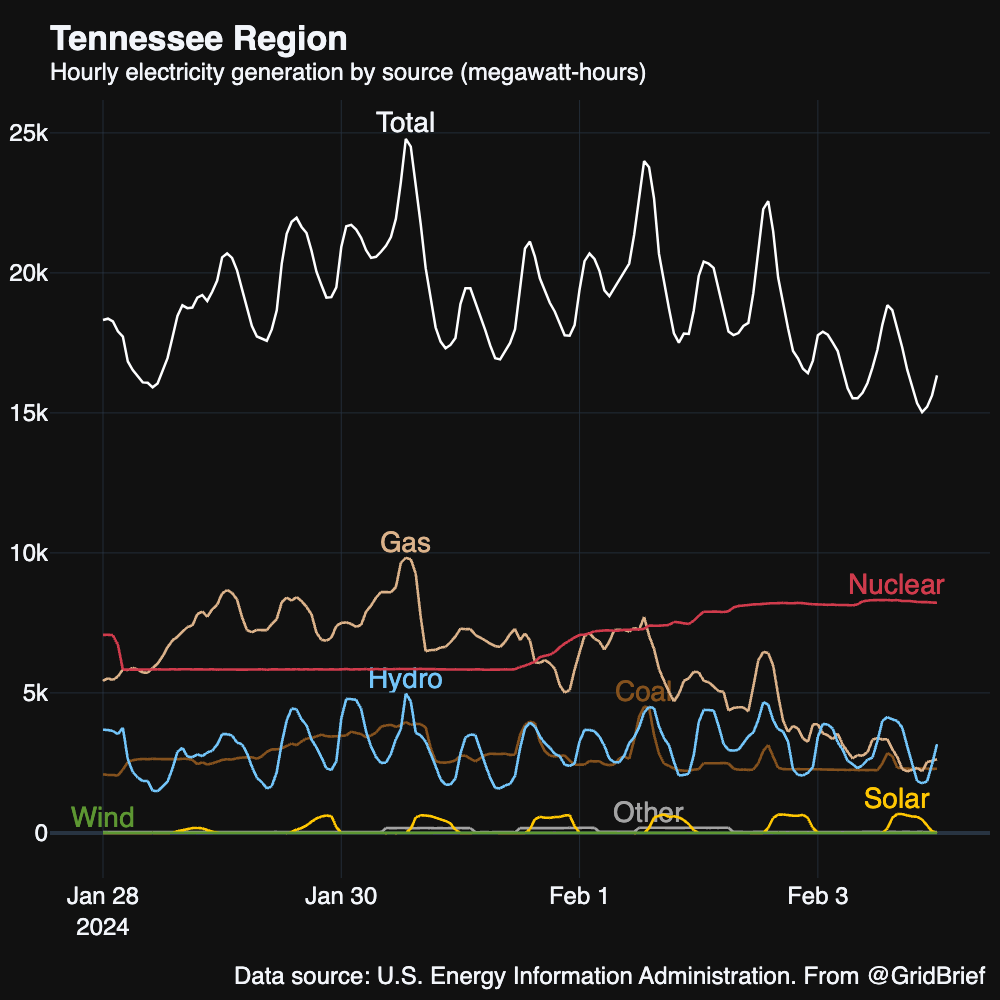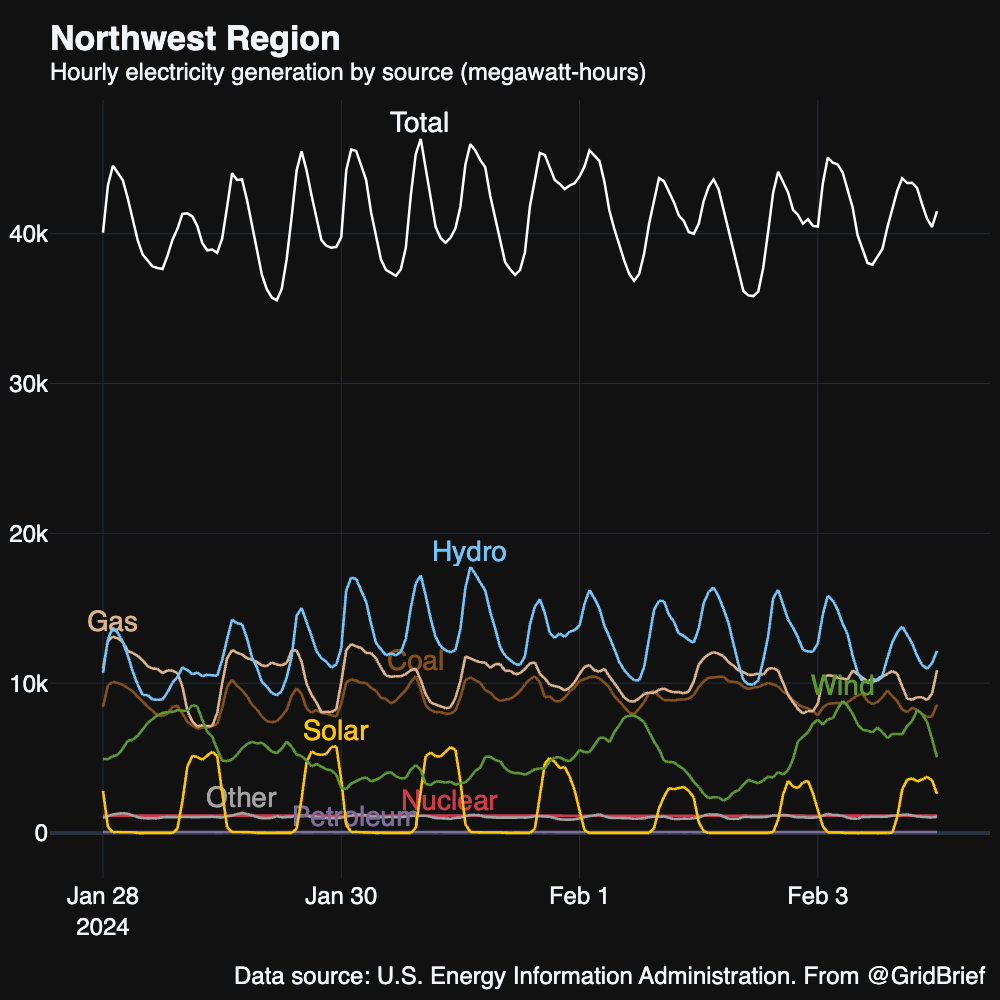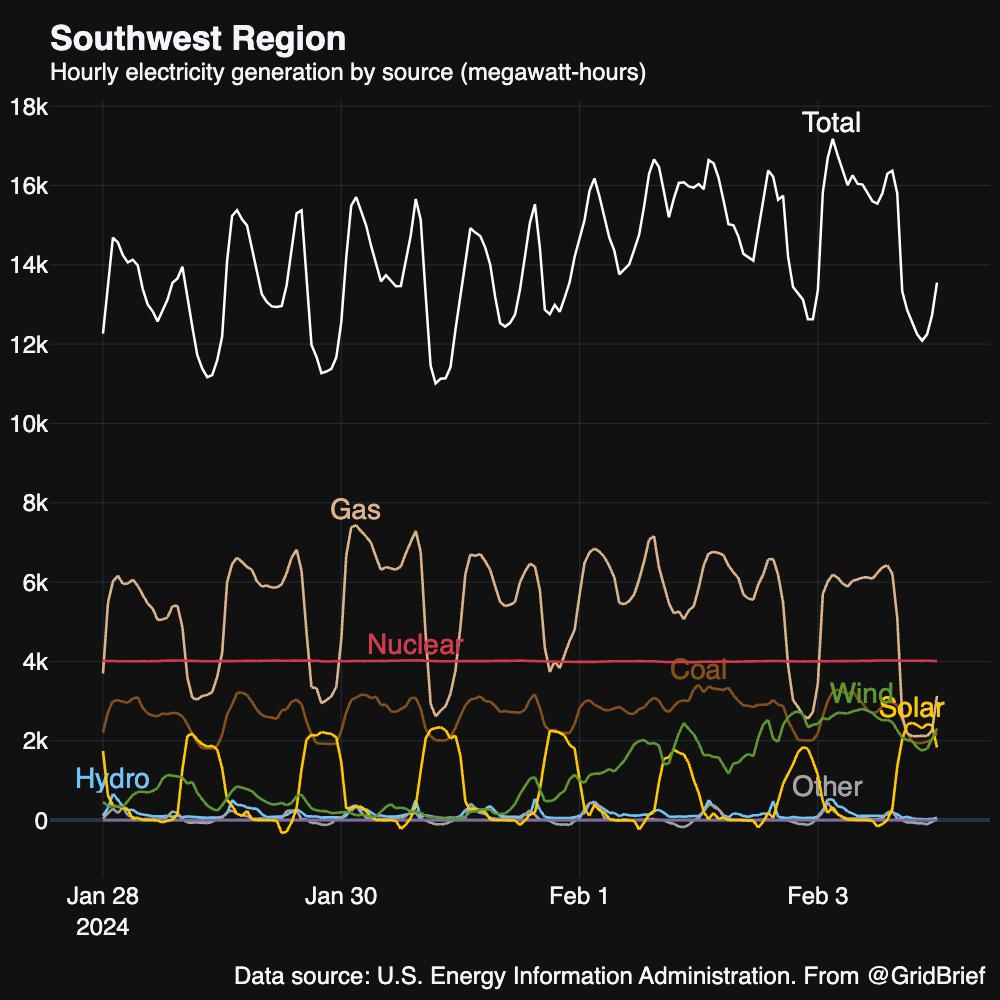Welcome to Grid Brief! Today, we’re looking at power generation in America’s traditional monopoly areas with relevant news items.
Monopoly Area Monday
Here’s a snapshot of generation nation-wide:

After falling from its high of 600k MWh last week, national total generation generally stayed within the bounds of 400k and 500k MWh. Natural gas, nuclear, and coal were the top generators, until wind usurped coal at the end of the week.
And here’s a map to orient you as we move through the areas:

Carolinas

The Carolinas saw total generation fall as compared to last week. Nuclear and natural gas were the top two generators. Solar and coal dueled for third until solar leapt over coal and natural gas at the end of the week.
South Carolina’s boom in growth has Duke Energy calling for more generators. “In a filing to the North Carolina Utilities Commission (NCUC), the utility forecasted even greater electricity demand than projected in the proposal last summer,” reports Power Engineering. “Duke said ‘new economic development wins, including manufacturing and technology projects across the Carolinas’ make up the primary driver of the increased electric demand. The utility said annual demand expects to increase 22% by 2030 and 25% by 2035 from 2022 planning cycles — driven by significant additional economic development activity that took place during 2023.”
TVA

In line with the nation-wide trend, the TVA’s total generation fell this week. Natural gas and nuclear scrummed for the top two spots until nuclear pulled away as total generation fell and gas’s ramping ability was no longer needed.
According to the Knoxville Sentinel, nuclear served as the TVA’s workhorse during the last month’s arctic blast.
Southeast

Natural gas, nuclear, and coal kept the lights on in the American Southeast.
Florida

Natural gas, solar, and “other” (a catch-all term for various generators that do not disclose their type to the Energy Information Administration) were the main generators in the Sunshine State. Feb. 1 saw an impressive spike in generation.
Duke Energy has promised Floridians that their rates will fall, but has remained vague about both the amount of the decrease and its timeframe. “Its current residential monthly charge for a customer using 1,000 kilowatt-hours of electricity, which is approximately the average consumption figure, is nearly $129. That amount breaks down to $79.19 for the base rate and $49.47 for fuel cost,” reports the Orlando Sentinel. “Its current residential monthly charge for a customer using 1,000 kilowatt-hours of electricity, which is approximately the average consumption figure, is nearly $129. That amount breaks down to $79.19 for the base rate and $49.47 for fuel costs.”
Northwest

Hydro, natural gas, and coal kept the Northwest humming.
House Republicans are moving to block Biden’s agreement with tribes in the Pacific Northwest to tear down hydrodams along the Snake River to spare the salmon populations. Recently, the Bonnevile Power Administration has also come out against breaching the dams.
"At times they can ramp to 3,000 megawatts. More importantly, they have a sustained peaking ability of about 2,300 megawatts. When you consider the average consumption of the city of Seattle is 1,000 megawatts, it shows you how much power these facilities can produce," said Doug Johnson, who serves as the Senior Spokesperson of Bonneville Power Authority. "That energy is vitally important to the Tri-Cities and everyone that is served by a PUD or a municipal electric utility or a cooperative in the northwest."
Southwest

Natural gas, nuclear, and coal were the top generators in the American Southwest.
Upgrade to Grid Brief Premium to get extra deep dives into energy issues all over the world.
Conversation Starters
Italy leans into solar production. “Italy will invest in Enel's photovoltaic panel factory in Sicily, supporting its plan to boost production and become Europe's main site for solar panels, Prime Minister Giorgia Meloni said on Saturday,” reports Reuters. "‘There are 90 million euros ($97 million) for this project from the National Recovery and Resilience Plan (NRRP)... which will allow the current factory to strengthen itself and for a further new production line to be established,’ Meloni said at the end of her visit to the 3Sun plant, in the city of Catania. ‘Our bet is for Catania to become one of the most important hubs in solar panel production,’ she added.”
Chile halts production at its second-biggest refinery. “Authorities in Chile’s Valparaiso region extended stay-at-home orders as forest fires continue to rage after killing at least 56 people in the country’s deadliest disaster since a massive earthquake in 2010,” reports Bloomberg. “Blazes that began on Friday spread through bushland and into populated areas on the edge of the coastal city of Viña del Mar, about 120 km (75 miles) northwest of Santiago, fed by blustering wind and high temperatures. Power and water services have been disrupted, causing Chile’s second largest oil refinery to halt operations. As firefighters continued to battle the blazes, authorities said the fires may have been intentionally lit.”
India bets on carbon capture. “India is set to launch a carbon capture policy that it says will allow it to keep exploiting its vast coal resources and deal with its growing emissions, according to to a top government energy adviser,” reports Bloomberg. “The policy is expected to be unveiled later this year – should Prime Minister Narendra Modi’s government retain power in upcoming elections — and will include incentives for companies to trap, recycle and where possible store their emissions underground, said Rajnath Ram, energy adviser at Niti Aayog, the policymaking branch of the Indian government.”
Crom’s Blessing

We rely on word of mouth to grow. If you're enjoying this, don't forget to forward Grid Brief to your friends and ask them to subscribe!